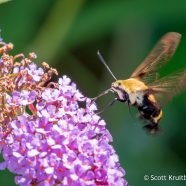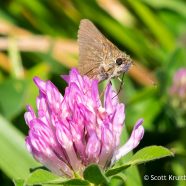Broad-winged Skipper (Poanes viator)
The uncommon skippers are starting to pop up more and more as butterflies fill the fields and meadows here in the late summer. This Broad-winged Skipper (Poanes viator) is a species of marshes and wet areas, though in this case it provided great views in a garden.
Read MoreSnowberry Clearwing Moth (Hemaris diffinis)
Earlier today I enjoyed my second Snowberry Clearwing Moth (Hemaris diffinis) of the summer, and the first in a situation where it was not unbelievably humid with such a high dew point that my camera immediately fogged up when taking it outside until the moth flew away and I was left with no images whatsoever…woo! All is forgiven, weather, so long as you keep up these beautiful conditions. By the way, moth, I like your bee outfit, too! Scott Kruitbosch Conservation & Outreach Coordinator
Read MoreButterfly Walk
Butterfly Walk at Stratford Point Saturday, September 10 at 10AM Stratford, Connecticut Leaders: Patrick Comins, Director of Bird Conservation, Audubon Connecticut Scott Kruitbosch, Conservation & Outreach Coordinator, Roger Tory Peterson Institute of Natural History Connecticut Butterfly Association Vice President Explore Stratford Point’s 28 upland acres filled with grasslands, pollinator meadows, feed plots, and a variety of shrubs and trees for common to rare species at this beautiful coastal site. This is one of the best places to find Monarchs in abundance in all of...
Read MoreRed Admiral Reflection
This was one finely crafted and very reflective Red Admiral (Vanessa atalanta) butterfly. It was only taking a drink of water, but it felt like much more.
Read MoreSwarthy Skipper
The Swarthy Skipper (Nastra lherminier) is a very small and mostly nondescript butterfly. These photos are of an individual earlier this spring in full sunlight. The tiny butterfly has some wear on it and is a bit faded. Their upperwings are a darker brown with underwing a light brown or yellow with some lighter edges and white veins. You can see it here feeding on a red clover flower, and it is even smaller! These nectar sources are common for the species as they will stay low in the grass in short or cut areas only adding to their inconspicuousness. As of today the only place we know they...
Read More








